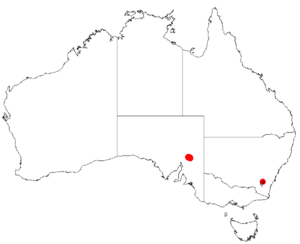Baratta wattle facts for kids
Quick facts for kids Baratta wattle |
|
|---|---|
| Conservation status | |
|
Rare
|
|
| Scientific classification | |
| Genus: |
Acacia
|
| Species: |
barattensis
|
 |
|
| Occurrence data from AVH | |
The Acacia barattensis, also known as Baratta wattle, is a type of shrub. It belongs to the Acacia family. This plant is special because it is endemic to a small area in South Australia. This means it only grows naturally in that specific place. The Baratta wattle is considered a rare plant.
What it Looks Like
The Baratta wattle is a shrub that usually grows about 2 to 3 meters (6.5 to 10 feet) tall. It is glabrous, which means it has no hairs. It is also viscid, meaning it feels a bit sticky. Its thin branches often have a black powdery coating.
Like most Acacia plants, it doesn't have regular leaves. Instead, it has special leaf-like parts called phyllodes. These phyllodes are thin and stand upright. They are usually slightly curved. They are also a bit sticky and have a strong smell. Each phyllode is about 5 to 10 centimeters (2 to 4 inches) long and 1 to 1.5 millimeters (0.04 to 0.06 inches) wide. They have three faint lines, or nerves, on each side.
The Baratta wattle blooms between April and December. Its flowers grow in round, pale yellow clusters. These clusters are called inflorescences. After the flowers, dark brown seed pods grow. These pods are flat and straight. They have thick, straw-colored edges. The pods are about 15 centimeters (6 inches) long and 3.5 millimeters (0.14 inches) wide. Inside, they hold hard, brown to black seeds. The seeds are oval-shaped and about 6 millimeters (0.24 inches) long and 2 millimeters (0.08 inches) wide.
How it Got its Name
A botanist named John McConnell Black first officially described this shrub in 1932. He wrote about it in a scientific paper. Later, in 2003, another botanist, Leslie Pedley, reclassified it. But in 2006, it was moved back to the Acacia group.
The Baratta wattle is part of a group of plants called the Acacia wilhelmiana group. Its specific name, barattensis, comes from Baratta Station. This is a large farm where the first plant sample, called the type specimen, was collected.
Where it Grows
The Baratta wattle is found in a small area of the Flinders Ranges in South Australia. It is a rare plant. People once thought it was extinct, meaning it had completely disappeared.
You can often find this wattle growing near rocky areas made of quartzite. It likes to grow along watercourses and on the sides of rocky valleys. It prefers thin, rocky soils. It grows in open woodlands or shrublands. You might see it growing with other trees like Eucalyptus camaldulensis, Eucalyptus flindersii, and Callitris glaucophylla.

